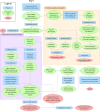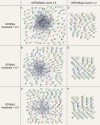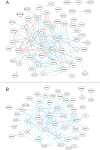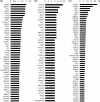Heterogenous circulating miRNA changes in ME/CFS converge on a unified cluster of target genes: A computational analysis
- PMID: 38157384
- PMCID: PMC10756525
- DOI: 10.1371/journal.pone.0296060
Heterogenous circulating miRNA changes in ME/CFS converge on a unified cluster of target genes: A computational analysis
Abstract
Myalgic Encephalomyelitis / Chronic Fatigue Syndrome is a debilitating, multisystem disease of unknown mechanism, with a currently ongoing search for its endocrine mediators. Circulating microRNAs (miRNA) are a promising candidate for such a mediator and have been reported as significantly different in the patient population versus healthy controls by multiple studies. None of these studies, however, agree with each other on which specific miRNA are under- or over-expressed. This discrepancy is the subject of the computational study presented here, in which a deep dive into the predicted gene targets and their functional interactions is conducted, revealing that the aberrant circulating miRNAs in ME/CFS, although different between patients, seem to mainly target the same specific set of genes (p ≈ 0.0018), which are very functionally related to each other (p ≲ 0.0001). Further analysis of these functional relations, based on directional pathway information, points to impairments in exercise hyperemia, angiogenic adaptations to hypoxia, antioxidant defenses, and TGF-β signaling, as well as a shift towards mitochondrial fission, corroborating and explaining previous direct observations in ME/CFS. Many transcription factors and epigenetic modulators are implicated as well, with currently uncertain downstream combinatory effects. As the results show significant similarity to previous research on latent herpesvirus involvement in ME/CFS, the possibility of a herpesvirus origin of these miRNA changes is also explored through further computational analysis and literature review, showing that 8 out of the 10 most central miRNAs analyzed are known to be upregulated by various herpesviruses. In total, the results establish an appreciable and possibly central role for circulating microRNAs in ME/CFS etiology that merits further experimental research.
Copyright: © 2023 Mateusz Piotr Kaczmarek. This is an open access article distributed under the terms of the Creative Commons Attribution License, which permits unrestricted use, distribution, and reproduction in any medium, provided the original author and source are credited.
Conflict of interest statement
The author has declared that no competing interests exist.
Figures




Similar articles
-
Identifying microRNAs Possibly Implicated in Myalgic Encephalomyelitis/Chronic Fatigue Syndrome and Fibromyalgia: A Review.Int J Mol Sci. 2024 Sep 3;25(17):9551. doi: 10.3390/ijms25179551. Int J Mol Sci. 2024. PMID: 39273498 Free PMC article. Review.
-
Circulating miRNAs Expression in Myalgic Encephalomyelitis/Chronic Fatigue Syndrome.Int J Mol Sci. 2023 Jun 24;24(13):10582. doi: 10.3390/ijms241310582. Int J Mol Sci. 2023. PMID: 37445763 Free PMC article.
-
MicroRNAs hsa-miR-99b, hsa-miR-330, hsa-miR-126 and hsa-miR-30c: Potential Diagnostic Biomarkers in Natural Killer (NK) Cells of Patients with Chronic Fatigue Syndrome (CFS)/ Myalgic Encephalomyelitis (ME).PLoS One. 2016 Mar 11;11(3):e0150904. doi: 10.1371/journal.pone.0150904. eCollection 2016. PLoS One. 2016. PMID: 26967895 Free PMC article.
-
Unravelling myalgic encephalomyelitis/chronic fatigue syndrome (ME/CFS): Gender-specific changes in the microRNA expression profiling in ME/CFS.J Cell Mol Med. 2020 May;24(10):5865-5877. doi: 10.1111/jcmm.15260. Epub 2020 Apr 14. J Cell Mol Med. 2020. PMID: 32291908 Free PMC article.
-
Early Growth Response Gene Upregulation in Epstein-Barr Virus (EBV)-Associated Myalgic Encephalomyelitis/Chronic Fatigue Syndrome (ME/CFS).Biomolecules. 2020 Oct 26;10(11):1484. doi: 10.3390/biom10111484. Biomolecules. 2020. PMID: 33114612 Free PMC article. Review.
Cited by
-
Identifying microRNAs Possibly Implicated in Myalgic Encephalomyelitis/Chronic Fatigue Syndrome and Fibromyalgia: A Review.Int J Mol Sci. 2024 Sep 3;25(17):9551. doi: 10.3390/ijms25179551. Int J Mol Sci. 2024. PMID: 39273498 Free PMC article. Review.
-
Key Pathophysiological Role of Skeletal Muscle Disturbance in Post COVID and Myalgic Encephalomyelitis/Chronic Fatigue Syndrome (ME/CFS): Accumulated Evidence.J Cachexia Sarcopenia Muscle. 2025 Feb;16(1):e13669. doi: 10.1002/jcsm.13669. J Cachexia Sarcopenia Muscle. 2025. PMID: 39727052 Free PMC article. Review.
References
-
- Kedor C, Freitag H, Meyer-Arndt L, Wittke K, Zoller T, Steinbeis F, et al.. Chronic COVID-19 Syndrome and Chronic Fatigue Syndrome (ME/CFS) following the first pandemic wave in Germany–a first analysis of a prospective observational study [Internet]. Infectious Diseases (except HIV/AIDS); 2021. Feb [cited 2022 Mar 22]. Available from: http://medrxiv.org/lookup/doi/10.1101/2021.02.06.21249256 - DOI
MeSH terms
Substances
LinkOut - more resources
Full Text Sources
Medical
Research Materials

